Best Scone Recipe (video)
Learn how to make the best scones of your life! These scones have a dark-golden and crunchy outer crust. They are tender, moist, and buttery on the inside. Plus you can easily adapt this recipe with your favorite add-ins.
What is a scone?
A scone is a pastry typically made with flour, butter or heavy cream, milk, eggs, baking powder, sugar, and salt. They can be sweet or savory. They are commonly served for breakfast, as a snack, or with your afternoon tea. American scones are usually triangular in shape and loaded with mix-ins and flavorings. They are also usually topped with coarse sugar or glaze for extra sweetness. British scones are generally round in shape and kept plain because they are customarily served with clotted cream and jam.
Why this recipe is so great:
- Some people might think of scones as dry, hard, and bland bricks of pastries, but I guarantee you this recipe is not like that at all. It’s quite the opposite actually. With this recipe, you get a very buttery and moist scone with a soft and tender inner crumb. The exterior is crunchy and baked to a dark golden perfection.
- This recipe is easy to make and you can customize it any way you want. You can use this recipe to make sweet or savory scones. It works with any combination of your favorite mix-ins.
- Here are some reviews:
“Love this recipe! I can’t stop making blueberry lemon scones. I find I have to leave mine in the oven a bit longer, but they come out perfect! I top them with a bit of butter and honey. Oh my goodness! So tasty!” – Monica
“Best scones I ever made! I usually use heavy cream but feel the buttermilk made the difference. After I brushed them with buttermilk, I sprinkled the top with sanding sugar and then made a vanilla glaze…only because I can’t leave well enough alone! I used 2 cups of frozen blueberries as an add-in. Excellent recipe!” – Julie
How to make scones:
(the ingredient amounts are listed in the printable recipe card further below)
- Start by tossing together the flour, sugar, baking powder, and salt in a large mixing bowl. Then add in the cold butter.
- Using a pastry cutter, fork, or two knives, work in the butter until the mixture resembles coarse meal with some larger pieces remaining.
- Toss in your add-ins.
- Whisk together the buttermilk, egg, and vanilla (if making sweet scones).
- Pour the wet ingredients over the dry ingredients and mix just until all is moistened.
- Scrape the dough onto a floured work surface.
- With floured hands, gently knead the dough into a ball. It doesn’t have to be perfectly smooth. Rough and shaggy is actually better.
- Flatten into a 6″ circle and cut into 8 wedges.
- Transfer onto a parchment paper-lined baking sheet and chill in the fridge for 20 minutes.
- Brush the surface with buttermilk and bake in a 400F oven for 20 minutes.
Expert tips:
- Use cold ingredients. Using cold butter, milk, and egg is essential for this recipe because you want the butter to remain solid while you work the dough. The small pieces of butter in the dough are what gives the scone its desirable texture. Cold butter creates steam as it melts in a hot oven. The steam from the melting butter expands between the layers of dough yielding a soft and fluffy interior, while the fat on the surface of the dough coats and creates a crispy outer shell.
- Be gentle and work quickly. When mixing your wet and dry ingredients together, gently mix until JUST combined and all appears to be moistened; that way you don’t create too much gluten. When kneading the dough into a ball, work quickly, so you don’t melt too much of the butter with your hands.
- Chill the dough. The key to this recipe is to let the scones chill in the fridge for 20 minutes while your oven preheats. This allows for the gluten in the flour to relax, which makes the scones more tender and enables them to rise higher. It also chills the fat, which makes the scones flakier.
FAQ:
Can scones be made in advance?
Yes, you can prepare the dough the night before, cover and store in the fridge overnight, and bake fresh in the morning. Baked scones will last in the fridge for up to 5 days, so you can also bake them in advance, and just reheat when ready to serve. To reheat, place them on a baking sheet lightly tented with foil, and warm in a 350F oven for about 10 minutes.
Can you freeze scones?
You can freeze them baked or unbaked. To freeze unbaked scones, place the wedges in the freezer until frozen solid, put them in a ziplock back, return to freezer and store for up to a month. When ready to bake, let thaw overnight in the fridge, and bake as instructed. To freeze them after baking, let cool completely, place in a ziplock bag, and freeze for up to a month. When ready to use, thaw overnight in the fridge, and warm in the microwave for 30 seconds or on a baking sheet lightly tented with foil in a 350F oven for about 10 minutes.
How do I get my scones to rise and be fluffy?
Make sure you are using enough baking powder and make sure it’s fresh. Don’t add too much flour when you knead the dough and don’t overwork the dough. Be very gentle and just work it enough to gather it into a shaggy ball. Letting the dough rest before baking also helps.
Do scones need eggs?
The answer is no. However, scones that contain eggs are fluffier and rise higher than scones that don’t because eggs serve as a leavening agent in baked goods. Eggs also add flavor, moisture, and richness to the scones so I highly prefer recipes that contain eggs.
Are scones supposed to be dry or moist?
Scones are supposed to be crunchy on the outside while soft and moist on the inside. They should not be dry or crumbly.
Why are my scones hard?
Scones can turn out hard for a number of reasons like overbaking, overworking the dough, the oven temperature being too high, not enough fats or liquids. However, it’s usually due to overbaking.
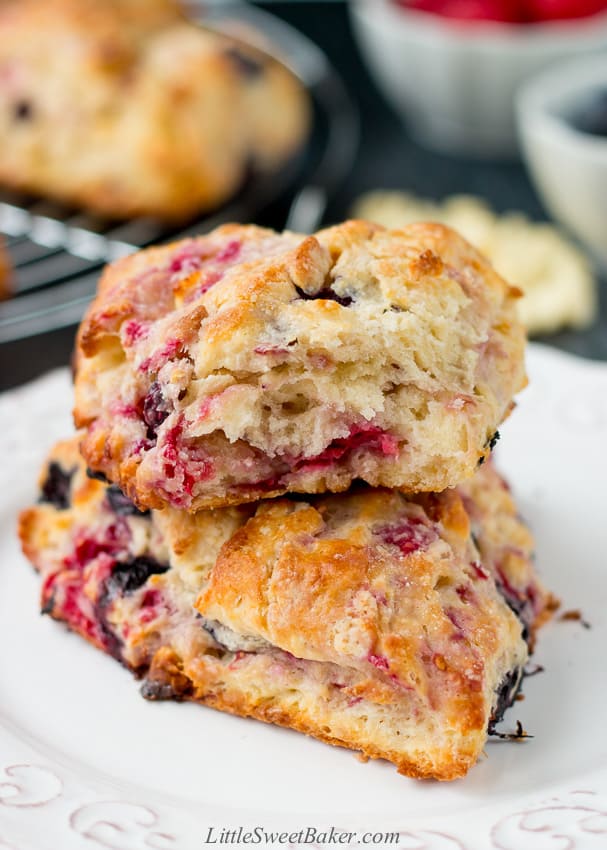
You might also like:
- Chocolate Chip Scones
- Best Blueberry Scones
- Feta Cheese & Blueberry Scones
- Flaky Butter Biscuits
- Bakery Style Blueberry Streusel Muffins
Did you make this recipe? Please kindly leave a comment with your star rating below.
Print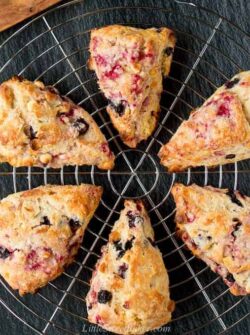
How To Make The BEST Scones
- Prep Time: 15 min
- Chill Time: 20 min
- Cook Time: 20 min
- Total Time: 55 minutes
- Yield: 8
- Category: breakfast, snack
- Method: bake
- Cuisine: American
Description
These scones have a dark-golden and crunchy outer crust. They are tender, moist and buttery on the inside. Plus you can easily adapt this recipe with your favorite add-ins.
Ingredients
- 2 1/2 cups (315g) all-purpose flour, plus more for work surface and kneading
- 2 tbsp (for savory) or 4 tbsp (for sweet) granulated sugar
- 1 tbsp baking powder
- 1 tsp (for savory) or 1/2 tsp (for sweet) salt
- ½ cup (114g) cold unsalted butter, cubed
- ⅔ cup (167ml) cold buttermilk, plus more for brushing top of scones
- 1 large egg
- 1 tsp vanilla (for sweet only)
Optional
- 1–2 cups add-ins (I used 1/2 cup white chocolate chips, 1/2 blueberries and 1/2 cup raspberries for this sweet scone version)
Instructions
- In a large bowl, toss together the flour, sugar, baking powder and salt.
- Work in the butter with a pastry cutter or fork until it resembles coarse meal with a few larger pieces remaining. Mix in any add-ins at this step if using.
- In a measuring cup, whisk together the buttermilk, egg, and vanilla (if making sweet scones).
- Pour the wet ingredients over the dry mixture. Gently stir with a rubber spatula until JUST combined and all appears to be moistened.
- Scrape the dough onto a floured work surface. With floured hands, gently and quickly knead the dough into a ball (sprinkle more flour if needed as you’re kneading). It doesn’t have to be smooth. Rough and shaggy is good.
- Pat out into a 5″ circle if making plain scones, or 6″ circle if you have incorporated any add-ins.
- Cut into 8 wedges and place 2″ apart onto a parchment paper or silicone mat lined baking sheet. Chill uncovered in the fridge for 20 minutes while you preheat your oven to 400F.
- Brush the tops of the scones with more buttermilk and bake for about 20 minutes or until golden brown.
Notes
Scones are best enjoyed the day of. Leftovers can be stored in an airtight container at room temperature for 2 days or in the fridge for up to 5 days. To reheat, place on a baking sheet, lightly tent with foil, and warm for 10 minutes at 350F.
To make in advance: prepare the dough the night before (up to step 5), cover and store in the fridge, and bake as instructed the next day. Baked scones will last in the fridge for up to 5 days, so you can also bake them in advance, and just reheat when ready to serve. To reheat, place them on a baking sheet lightly tented with foil, and warm in a 350F oven for about 10 minutes.
To freeze unbaked scones: place the wedges in the freezer until frozen solid, put them in a ziplock back, return to freezer and store for up to a month. When ready to bake, let thaw overnight in the fridge, and bake as instructed.
To freeze them after baking: let the scones cool completely, place them in a ziplock bag, and freeze for up to a month. When ready to use, thaw overnight in the fridge, and warm in the microwave for 30 seconds or on a baking sheet lightly tented with foil in a 350F oven for about 10 minutes.
Here are some suggested variations from King Arthur Flour.
Sweet scone variations:
White Chocolate, Cherry, and Pecan Scones: Add 1/2 cup dried cherries, 1/2 cup white chocolate chips, and 1/2 cup pecans.
Chocolate Chunk Scones: Add 1 – 1 1/2 cups of chocolate chunks (milk, semi-sweet, dark or mix).
Double Chocolate Chunk Scones: Substitute 1/4 cup cocoa powder for 1/4 cup of the all-purpose flour; add 1 cup chocolate chunks and 1/2 teaspoon espresso powder.
Toasted Coconut Lime Scones: Add 3/4 cup toasted unsweetened shredded coconut and 1 tablespoon lime zest. For extra coconut flavor, use coconut milk in place of the dairy called for in the recipe.
Roasted Strawberry and Pistachio Scones: Toss 2 cups sliced or quartered strawberries with 1 tablespoon sugar. Spread them on a parchment-lined baking sheet and bake at 425°F for about 20 minutes, or until jammy-looking. Let the berries cool before stirring them into the dry ingredients with 1/2 cup chopped pistachios.
Lemon Blueberry Scones: Add 2 cups blueberries and 1 tablespoon lemon zest.
Triple Cinnamon Scones: Add 2 teaspoons ground cinnamon (to the dry ingredients) and 1 cup cinnamon chips.
Savory scone variations:
Cheddar, Basil, and Sun-Dried Tomato Scones: Add 1 cup grated cheddar, 1/4 cup chopped fresh basil (or 2 tablespoons dried basil), and 1/2 cup chopped sun-dried tomatoes (not packed in oil).
Cheddar, Bacon, and Chives: Add 1 cup grated cheddar, 1/2 cup cooked crumbled bacon, 2 tbsp finely chopped fresh chives (or 2 tsp dried).



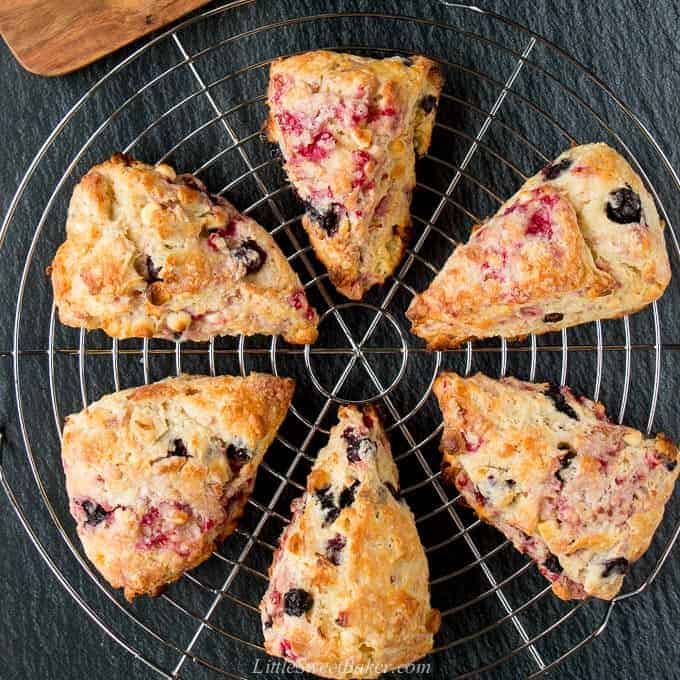
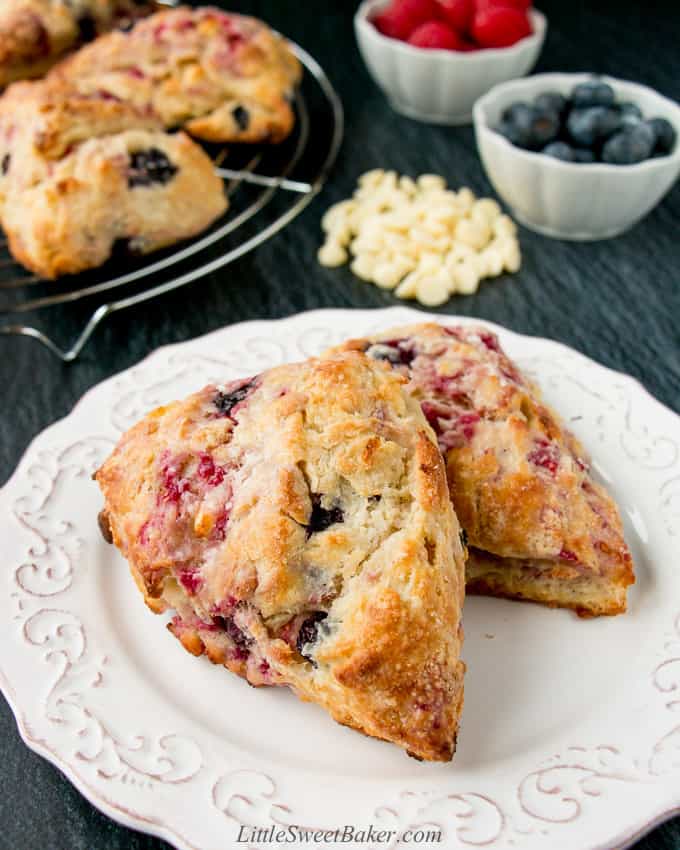
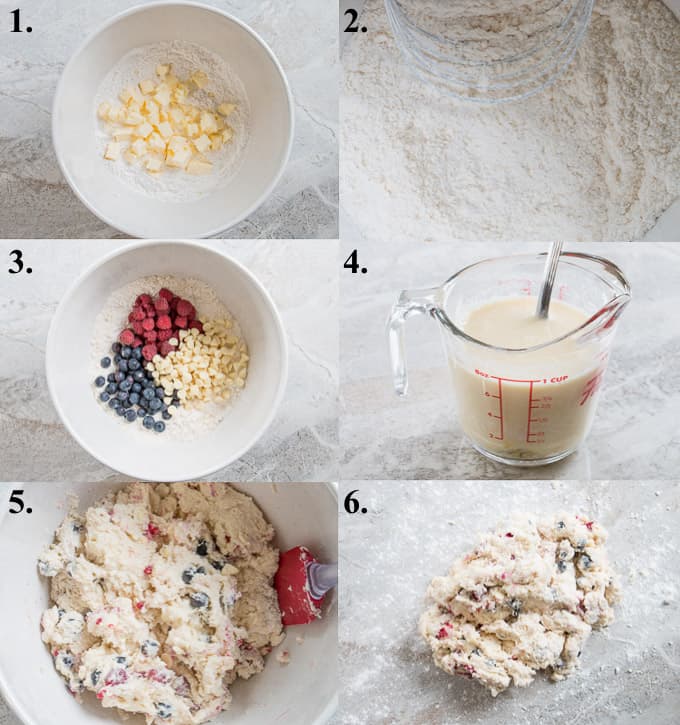
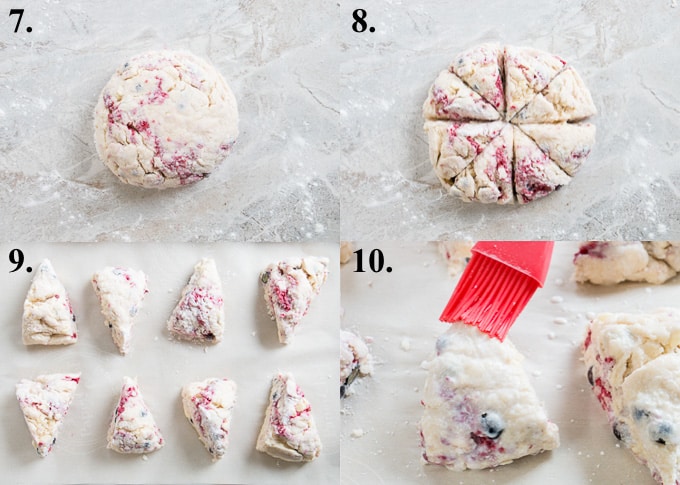


I love this recipe and use it for many variations! Thank you!
I made your berry scones and they were so good!!! I was so impressed with myself. I could have left them in the oven just a few minutes more, just to get them super crunchy on the outside, but they were so moist.
My go-to scone recipe! Thank you!!! It works beautifully for both sweet and savory. For sweet I use dried apricots and candied ginger and for savory, sausage, scallions and cubed Gruyère. Moist and delicious. Love that it uses buttermilk because I usually have it on hand. Thank you again for sharing!
You’re very welcome and I love your savory combo – yum!
I made sweet scones with two cups of frozen cranberries and the zest from one lemon, and they turned out FABULOUS!! The recipe is so easy!! This is my second batch of scones ever, and I’m so happy I found your recipe. Unfortunately, I used a different recipe (which I’ve since deleted) the first time I made scones and the difference was night and day. I can’t wait to try other variations (cherry almond is next), as well as some savory ones. Thanks for sharing the recipe!!
You’re very welcome and thank you for your kind words, Whitney! Enjoy:)
How much salt should I use? It’s in the instructions but there isn’t an amount given. I added two pinches. But what do you recommend?
1 tsp for savory or 1/2 tsp for sweet. It’s listed just below the baking powder but I can see how that can be missed.
Hello!
I made your scone recipe today and found it super easy and quick. I made buttermilk with sour cream and had to also make the milk portion with half n half /water mix. I made 1 cup and accidentally poured it all in. The scones worked perfectly with only 5 mins extra bake time.
Thanks for posting your recipes.
You’re very welcome and thank you for your kind words!
These scones are just wonderful. Easy to make and just perfect!
Are the fruit – dried or fresh?
They are fresh but you can use dried.
I wish you said to add in the “add ins” in the recipe. I’ve made these twice and both times flattened it out in the circle then remembered the add ins. Otherwise they are good
Hi Karla,
In step 2 it does say “Mix in any add-ins at this step if using.” but I can see how that can be missed. Glad it still turned out good though!
This is truly THE BEST scone recipe ever! I bake them on two sheets stacked to keep the bottoms from burning and they come out perfect every time.
I’d like to use pumpkin next but I’m not sure how to incorporate such a wet ingredient – any suggestions?
Hi Megan, thank you for your kind words. I have a similar recipe for pumpkin scones https://www.littlesweetbaker.com/pumpkin-scones/ I hope you like it just as much!
Hi Lily,
Thank you so much for your reply!! As a newbie baker I was curious why you opted for half & half in the pumpkin recipe rather than buttermilk?
Warmly,
Megan
Great question! Since pumpkin already has so much water in it, half and half works better because I can use less and still have about the same amount of richness. I hope that clarifies and let me know if you have any further questions:)
Great, easy to follow recipe! I used it to make chocolate chip scones yesterday, and they came out so good I just had to make more scones today. This time I added raspberries, blueberries and white chocolate like yours – they are fantastic. Golden brown and crispy on the outside, fluffy and moist on the inside. This is the perfect scone recipe and I’m going to use it many more times in the future!